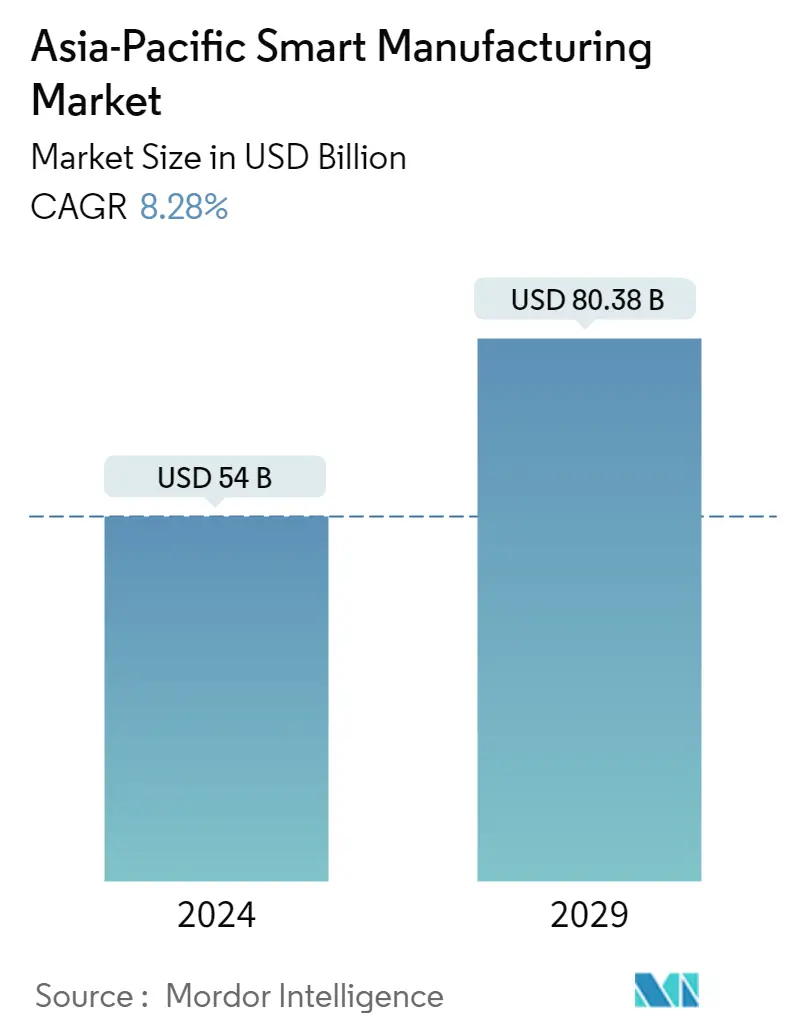Market Size of Asia-Pacific Smart Manufacturing Industry

| Study Period | 2019 - 2029 |
| Base Year For Estimation | 2023 |
| Market Size (2024) | USD 54.00 Billion |
| Market Size (2029) | USD 80.38 Billion |
| CAGR (2024 - 2029) | 8.28 % |
| Market Concentration | Low |
Major Players
*Disclaimer: Major Players sorted in no particular order |
APAC Smart Manufacturing Market Analysis
The Asia-Pacific Smart Manufacturing Market size is estimated at USD 54 billion in 2024, and is expected to reach USD 80.38 billion by 2029, growing at a CAGR of 8.28% during the forecast period (2024-2029).
Manufacturing is one of the most significant contributors to Asia-Pacific's economy and is undergoing a rapid transformation. As the population ages, along with rising labor costs in Europe and North America, the legacy model based on inexpensive workers is no longer sustainable. Due to such factors, low-end manufacturing firms are increasingly moving their operations to Southeast Asia to cut costs.
- Industry 4.0 is the latest revolution in the manufacturing landscape. Factories integrate production machines, wireless connectivity, and sensors and link them to a system platform ecosystem that oversees the production line process and executes decisions autonomously. With the help of smart manufacturing, regional manufacturers can transform businesses and achieve significant value by leveraging the Industrial Internet of Things (IIoT), cloud, and analytics solutions.
- Big data analytics can refine complicated processes and support new business models, like mass customization and product-as-a-service (which can be made possible by smart manufacturing), apart from the traditional operational models like "on-demand." As big data analytics allows an enterprise to use smart manufacturing to shift from reactionary practices to predictive ones, The increase in industrial 4.0 practices across various manufacturing industries provides more scope for accepting big data analytics in the region.
- Manufacturing has emerged as one of the high-growth sectors in India. The "Make in India" program places India on the world map as a manufacturing hub and provides global recognition to the Indian economy. In order to succeed in the "Make in India" program, manufacturers in India need to manufacture more efficiently and deploy innovation to stay competitive. Smart manufacturing solutions can help with that. Manufacturers can focus more on enhancing competitiveness by streamlining supply chains, reducing costs, and improving safety in the workplace. Simultaneously, solutions like robotics, analytics, and cybersecurity strengthen their ability to meet quality norms.
- Further, the automated industrial economy has opened in Japan, and the development of Industrial Version 4.0 is speeding up. Japan has become a manufacturing hub for factory automation products, supplying them to other regional markets in the Asia-Pacific region and making factory automation more affordable. Products from Japan are prone to lower shipment costs and have better after-sales support networks in the region.
- With the Made in China 2025 initiative allowing the relocation of manufacturing back to China, Southeast Asian countries are under pressure to ascertain and minimize the risk of labor issues, and Industry 4.0 is currently impacting smart manufacturing development in the region. Moreover, most regional companies need to become more familiar with the benefits of Industry 4.0 on productivity and growth. It is estimated that if adopted and implemented correctly, Industry 4.0 has the potential to increase productivity by 30-40%.
APAC Smart Manufacturing Industry Segmentation
Smart manufacturing utilizes big data analytics, robotics, machine vision systems, sensors, and transmitters to refine complicated processes and manage supply chains. These solutions allow an enterprise to use smart manufacturing to shift from reactionary practices to predictive ones. This change targets improved efficiency of the process and performance of the product.
The Asia Pacific Smart Manufacturing Market is segmented By Enabling Technologies (Industrial Control Systems, Industrial Robotics, Machine Vision Systems, Cloud, Analytics and Platforms, Cybersecurity, Sensors & Transmitters, Connectivity/Communication, and Other Field, Control and Safety Solutions), By End-user Industry (Automotive, Semiconductor, Oil and Gas, Chemical and Petrochemical, Pharmaceutical, Aerospace and Defense, Food and Beverages) and By Country. The market sizes and forecasts are provided in terms of value (USD million) for all the above segments.
| Enabling Technologies | ||||||||
| ||||||||
| Industrial Robotics | ||||||||
| Machine Vision Systems | ||||||||
| Cloud, Analytics and Platforms | ||||||||
| Cybersecurity | ||||||||
| Sensors & Transmitters | ||||||||
| Connectivity/Communication | ||||||||
| Other Field, Control and Safety Solutions |
| End-user Industry | |
| Automotive | |
| Semiconductor | |
| Oil and Gas | |
| Chemical and Petrochemical | |
| Pharmaceutical | |
| Aerospace and Defense | |
| Food and Beverages | |
| Other End-user Industries |
| Country | |
| China | |
| India | |
| Japan | |
| South Korea | |
| Rest of Asia-Pacific |
Asia-Pacific Smart Manufacturing Market Size Summary
The Asia-Pacific smart manufacturing market is experiencing significant growth, driven by the region's pivotal role in the global manufacturing landscape. As traditional manufacturing models become less viable due to rising labor costs and an aging population, the adoption of Industry 4.0 technologies is transforming the sector. This revolution involves integrating advanced technologies such as the Industrial Internet of Things (IIoT), cloud computing, and big data analytics into manufacturing processes. These innovations enable manufacturers to enhance efficiency, reduce costs, and improve product quality, thereby maintaining competitiveness in a rapidly evolving market. Countries like India and Japan are at the forefront of this transformation, with initiatives like "Make in India" and advancements in factory automation, respectively, bolstering their manufacturing capabilities.
China plays a crucial role in this regional shift towards intelligent manufacturing applications, with government initiatives aimed at becoming a global leader in AI and smart manufacturing by 2030. The country's focus on integrating AI technologies and data analytics into manufacturing processes is helping optimize operations and reduce costs. The fragmented market in Asia-Pacific sees numerous international companies, such as ABB Ltd., Honeywell International Inc., and Siemens AG, offering solutions to enhance manufacturing productivity. These companies are engaging in strategic partnerships and innovations to expand their market presence. The ongoing development of smart manufacturing technologies presents substantial opportunities for growth across various industries, including oil and gas, where predictive maintenance and data analytics are becoming increasingly vital.
Asia-Pacific Smart Manufacturing Market Size - Table of Contents
-
1. MARKET INSIGHTS
-
1.1 Market Overview
-
1.2 Industry Attractiveness - Porter's Five Forces Analysis
-
1.2.1 Bargaining Power of Suppliers
-
1.2.2 Bargaining Power of Consumers
-
1.2.3 Threat of New Entrants
-
1.2.4 Threat of Substitute Products
-
1.2.5 Intensity of Competitive Rivalry
-
-
1.3 Impact of COVID-19 on the Overall Manufacturing Industry and Their Spending on Digital Initiatives
-
-
2. MARKET SEGMENTATION
-
2.1 Enabling Technologies
-
2.1.1 Industrial Control Systems
-
2.1.1.1 Programmable Logic Controller (PLC)
-
2.1.1.2 Supervisory Controller and Data Acquisition (SCADA)
-
2.1.1.3 Distributed Control System (DCS)
-
2.1.1.4 Human Machine Interface (HMI)
-
2.1.1.5 Product Lifecycle Management (PLM)
-
2.1.1.6 Manufacturing Execution System (MES)
-
-
2.1.2 Industrial Robotics
-
2.1.3 Machine Vision Systems
-
2.1.4 Cloud, Analytics and Platforms
-
2.1.5 Cybersecurity
-
2.1.6 Sensors & Transmitters
-
2.1.7 Connectivity/Communication
-
2.1.8 Other Field, Control and Safety Solutions
-
-
2.2 End-user Industry
-
2.2.1 Automotive
-
2.2.2 Semiconductor
-
2.2.3 Oil and Gas
-
2.2.4 Chemical and Petrochemical
-
2.2.5 Pharmaceutical
-
2.2.6 Aerospace and Defense
-
2.2.7 Food and Beverages
-
2.2.8 Other End-user Industries
-
-
2.3 Country
-
2.3.1 China
-
2.3.2 India
-
2.3.3 Japan
-
2.3.4 South Korea
-
2.3.5 Rest of Asia-Pacific
-
-
Asia-Pacific Smart Manufacturing Market Size FAQs
How big is the Asia-Pacific Smart Manufacturing Market?
The Asia-Pacific Smart Manufacturing Market size is expected to reach USD 54.00 billion in 2024 and grow at a CAGR of 8.28% to reach USD 80.38 billion by 2029.
What is the current Asia-Pacific Smart Manufacturing Market size?
In 2024, the Asia-Pacific Smart Manufacturing Market size is expected to reach USD 54.00 billion.

